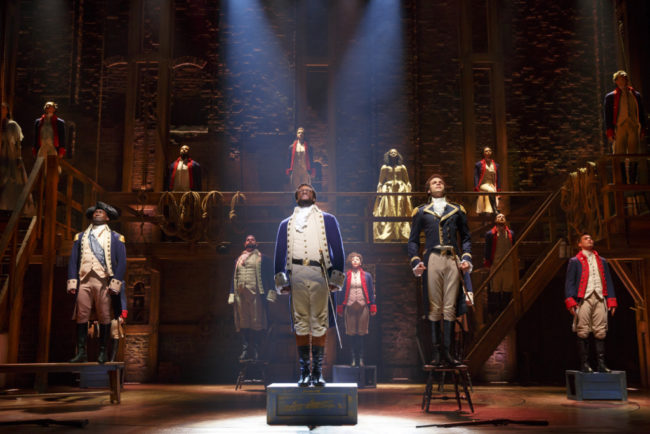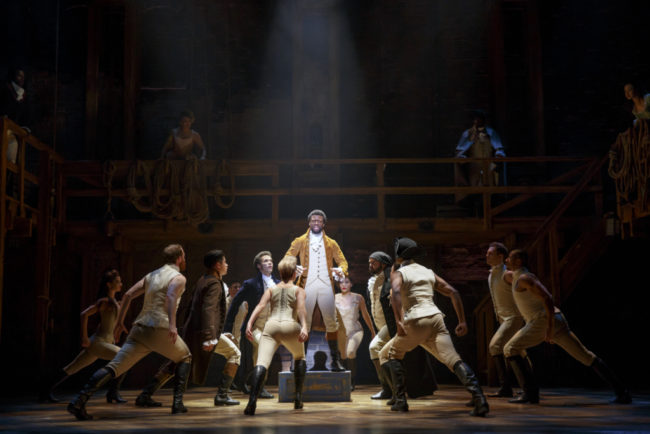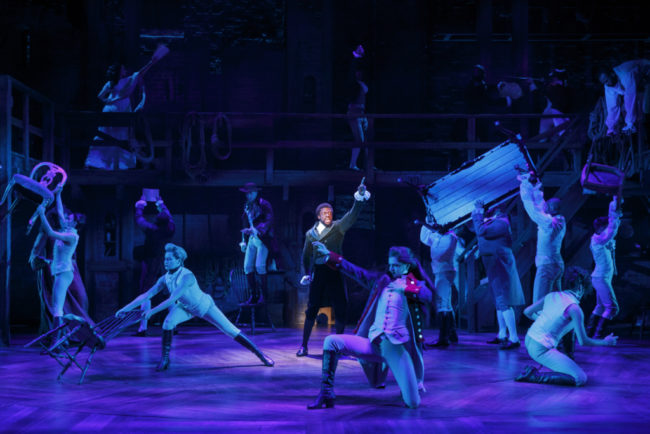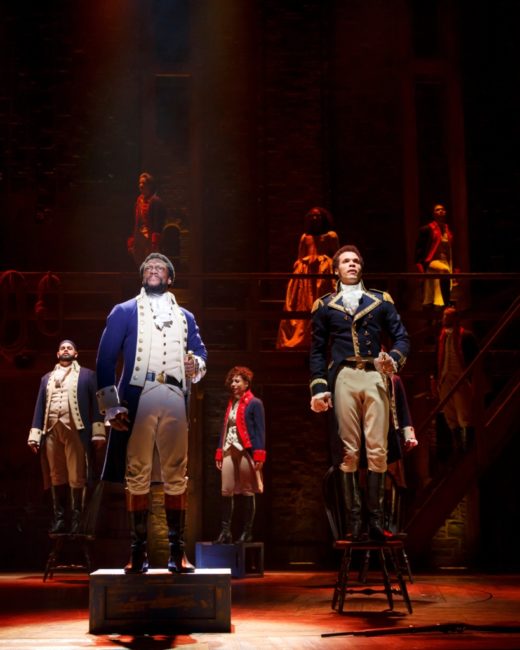There are moments that the words don’t reach. Seeing the musical sensation that’s sweeping the nation with its razzle-dazzle rhyme in Lin-Manuel Miranda’s prime is supposed to be one of them, and not just one of them, but the biggest one of them, all the people coast to coast begging for the musical with the most finally have their shot— and they are not throwing away their shot— not this summer— because Hamilton has arrived. Hamilton is here. And audiences all over Washington DC are flocking to The John F. Kennedy Center for the Performing Arts for their shot to be in the room where it happened this summer. Tickets are extremely limited but still available for Hamilton as it plays the Opera House stage for its 14-week engagement here in the nation’s capital city. With Music, Book, & Lyrics by Lin-Manuel Miranda, the 11-time Tony Award-Winning musical is young, hungry, and scrappy, and not throwing away its shot to draw in unprecedented amounts of audiences this summer.

It’s a production loaded with spectacle, to be sure, but whether or not that makes for a stellar performance remains to be seen. While Andy Blankenbuehler sets the stage with some bombastic, explosive, and seriously intense choreography all throughout the performance, there is much to be said for the way the style of movement syncs up with the musical numbers. Hamilton is a new form of musical theatre, blending rap, hip-hop, and other musical styles into the traditional storytelling format, and it is not without its praises and high points. That said, the current production does at times fall short of the sensationalized hype that has been built up all around its namesake.
While the rapping and hip-hop musical styling itself isn’t a problematic issue— and all praises directly to Lin-Manuel Miranda for some of the most poignant and clever rhyming lyrics to ever hit the stage— it’s the delivery in this production that causes somewhat of a disconnect to the storytelling narrative. Despite repetition in Miranda’s book and lyrics, there are large segments of rapped numbers that are just not articulated clearly. Whether this is the performers themselves or the sound design and balance inside the Opera House (by way of Sound Designer Nevin Steinberg) is unclear, but it makes following along to lyrics and the story difficult, even for those who have memorized the original cast recording or are extremely familiar with the words.
Miranda’s book is not flawless and at times the jumble of things happening is overwhelming. Not unlike other musicals to come before him, Miranda approaches the show musically with a variety of styles, and this is actually one of the show’s stronger suits— featuring rap, hip-hop, even a glorious jazzy blues number at the top of the second act, as well as more traditional musical theatre ballads— all of which complete the blurry masterwork that is Hamilton. At times there is narrative dissonance; the work may have been stronger served had the story been told strictly with Aaron Burr as the narrative guiding force or perhaps directly and only from Hamilton’s point of view, but the division between the pair leaves audiences jumping desperately between the storytelling onus of the show and ultimately creates a disconnect from the plot as it progresses.

David Korins’ scenic design, Paul Tazewell’s costume design, and Howell Binkley’s lighting design all come together blazing a conflagration that plays into the heightened sense of spectacle that accompanies the production. There are moment of sheer breath-taking astonishment when the lights are blinking in a mad fever in time with the music, augmented exponentially by Andy Blankenbuehler’s indefatigable choreography. There are moments of stunning stillness that allow the striking beauty of Miranda’s lyrics to radiate with all of the vibrant glory of night-sky fireworks. Multiple viewings of the production are suggested to fully consume, digest, and process the experience.
While Blankenbuehler’s dancing ensemble cannot be beat, even if at times their intense dance routines are overwhelming, there are members of the ensemble in cameo roles that are well worth praising. Isa Briones, who doubles up in the role as the precocious, albeit briefly experienced, Peggy Schuyler and later as Maria Reynolds, showcases a striking versatility in these two women despite only being featured briefly. Briones’ Peggy has that peppy punch of pluck while her Maria Reynolds is smoldering and smoky. In the same category as Briones, though for different reasons, is the boisterously bubbly Peter Matthew Smith with his portrayal of King George. While his three numbers are purely for comic relief, “You’ll Be Back”, “What Comes Next”, and “I Know Him” are true comedic gemstones and delivered with such a flare that you’ll fall from the chair with laughter.
Bryson Bruce puts his character duality to the test in the dual role of Marquis de Lafayette and Thomas Jefferson. With the thick French accent for the Lafayette, of which he articulates clearly, Bruce puts the fire of revolutionary spirit into numbers like “My Shot” and “The Story of Tonight.” As Jefferson, Bruce all but steals the show with his outrageous dancing and carrying on during “What’d I Miss?” This number is arguably one of the most intensely involved numbers when it comes to the more traditional musical-theatre-styled numbers featured in the production.

Carvens Lissaint presents a proud and commanding George Washington. Lissaint creates the character with gusto and vigor, and though at times his rapped exchanges are difficult to be heard for lack of articulation, when he slows down his pattern of delivery, it comes sailing forth with great reverence and severe emotional intention. Lissaint blows the audience away with his soulful solo featured during “One Last Time”, fully encompassing the emotional gravity of the George Washington character in this number.
The other two Schuyler sisters— Angelica (Sabrina Sloan) and Eliza (Julia K. Harriman)— are enigmatic creations that are dealt incredibly complex songs and deeply flawed character constructions, which both Sloan and Harriman manage to rise above. Sloan, who hangs the Angelica character’s hat on “Satisfied” creates astonishing moments of emotional connectivity in this R&B-pop style ballad, forcing the audience to stay focused on the fact that the song is essentially a fantastical rewind in the vein of “what might have been.” Vocally consistent throughout the performance, Sloan is well-suited for the role. Harriman, as Eliza the wife of Hamilton, finds her promising 11-o’clock number in “Who Lives, Who Dies, Who Tells Your Story” despite being the last individual to take solo lines in the song. Full of compassion and emotional grace, this number, along with her rendition of “Helpless” are the moments where the Eliza character finds her place in the show.
The show may be called Hamilton but Aaron Burr (Nicholas Christopher) is given almost equal parts focus and the way his story wraps around and through the story of Alexander Hamilton (Austin Scott) is almost as present and palpable as the namesake’s side of the tale. Christopher, as Burr, is lively and present, deeply engrossed in his narrative element in addition to being a deteriorating gentleman. Christopher transfixes the audience with the way he traverses the Burr-character arc, transforming him from a simple friend to the villain of history we’ve come to know. One of the more engagement moments share between the pair arrives during “Your Obedient Servant.” Christopher breaks out all the skills— rapping, singing, emotionally expressing— for his finale during “The World Was Wide Enough” and brings the show into its final moments with vigorous enthusiasm.
Austin Scott has a fiery gumption that fuels his delivery of the titular character. “My Shot” gives the audience a mere taste of the loose cannon ready to spark and erupt as the show progresses. Hitting the peak of delirium during “The Reynolds Pamphlet” there is something incendiary about the way Scott controls the character in this number. While Scott does not sing as Hamilton in “It’s Quiet Uptown” the serene silences of reflection shared here between Hamilton and wife give depth to Scott’s portrayal. It is a loaded torch to bare, this flame that is Alexander Hamilton, and Scott does so to the best of his capabilities.

Ultimately an experience, audiences in Washington DC are encouraged to not throw away their shot and procure tickets (or a spot on the waiting list) as quickly as possible for this limited-run 14-week engagement of Hamilton.
Running Time: 2 hours and 50 minutes with one intermission
Hamilton plays through September 16, 2018 on the Opera House Stage at The John F. Kennedy Center for the Performing Arts— 2700 F Street NW in the heart of Washington, DC. Tickets are extremely limited but still available for purchase by calling the box office (202) 467-4600 or by ordering them online.
